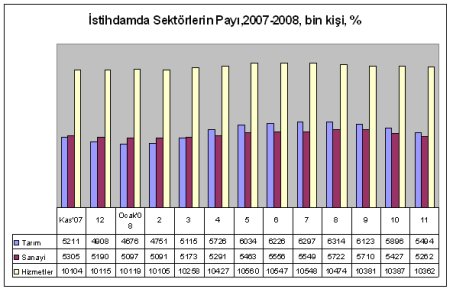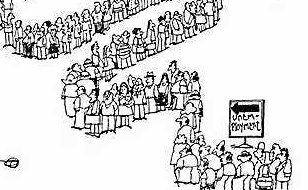New data published by the Turkish Statistical Institute (TÜİK) based on November 2008, estimates current unemployment at nearly 3 million (2 million 995 thousand), a rate of 12.3 percent.
Labour force is growing
Compared to the November of the previous year, 2007, this represented an increase in the number of unemployed people by 645,000 people.
During this year, 1 million 93 thousand people have been added to the labour force, but only 448,000 of them have found employment; the other 645,000 people have caused the increase in unemployment.
Industrial sector hit hardest
If one looks at how unemployment is distributed in the different sectors (agriculture, industry, services), 283,000 more people have been employed from November to November, while 43,000 people lost jobs in the industry. There was an increase of 258,000 jobs in the service sector in the same period.
This shows that last year, it was the industrial sector where employment decreased, and this is an important trend.
The figure below shows the number of people employed in the different sectors (in thousands) during the different months of that period, starting with November 2007 (Kas ’07). The agricultural sector is in blue, the industrial sector in purple, and the services sector in white.

The most important issue, however, is that among the 24.3 million people in the labour force, there are in fact more than the officially-quoted three million unemployed. They are hidden because they are not counted as part of the labour force, and this prevents us from seeing the real dimensions of current unemployment.
Hidden unemployment
In order to calculate the real rate of unemployment, one would have to add all the people who have given up hope of finding work and are thus not actively seeking employment, those who work on a seasonal basis only, and those who are underemployed.
As a matter of fact, there has been a steep rise in this category of “hidden” unemployment. For instance, the number of people who have given up looking for work rose from 630,000 to 717,000 in one year. Those who said they would work if they found work made up 1 million 40,000 a year ago, but this number has risen to 1 million 251 thousand. There are 409,000 seasonal labourers. The number of people who are underemployed, that is who work provisionally, has risen from 600,000 to 855,000.
If one adds all of these unemployed people to the official numbers, then the real number of unemployed people is not 2 million 995 thousand, but 6 million 223,000. This means an unemployment rate not of 12.3 percent, but of 25.8 percent.
Rapid increase in real unemployment does not bode well for future
If one considers then that the real unemployment rate was 21.9 percent in November 2007, and 22 percent in November 2006, this shows that there has been a rapid increase.
In addition, one can say that the November 2008 data on unemployment has yet to reflect the economic decline which has become more rapid in the last three months.
It has already become apparent that the industrial sector (including construction) is losing rather than creating jobs. It is obvious that the increase in unemployment in industry will affect the services sector. As a result, the unemployment figures of the next months will be worrying.


